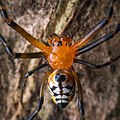| Leucauge fastigata | |
|---|---|
 | |
| Leucauge fastigata, Guam | |
| Scientific classification | |
| Domain: | Eukaryota |
| Kingdom: | Animalia |
| Phylum: | Arthropoda |
| Subphylum: | Chelicerata |
| Class: | Arachnida |
| Order: | Araneae |
| Infraorder: | Araneomorphae |
| Family: | Tetragnathidae |
| Genus: | Leucauge |
| Species: | L. fastigata |
| Binomial name | |
| Leucauge fastigata (Simon, 1877) | |
| Subspecies | |
| |
| Synonyms | |
| |
Leucauge fastigata, the pear-shaped leucauge, is a species of spiders in the family Tetragnathidae (long-jawed orb weavers). Its native range extends from India to the Philippines and Sulawesi.
Contents
Members of the species have silvery or golden spots on the abdomen. They are elongated spiders with long legs and chelicerae.
They are orb web weavers, weaving small orb webs with an open hub and few, wide-set radii and spirals. The webs have no signal line and no retreat. The web is a large horizontally-placed orb structure with a diameter of more than a metre. The entire web is often suspended by several long strands of silk attached to branches and leaves nearby.
This species is separated from other Leucauge spiders by its pear-shaped abdomen and its unique fourth leg. In addition to the two rows of curved hairs (characteristic of Leucauge), this leg also has a thick brush of spines which are not present in most other species of Leucauge.



